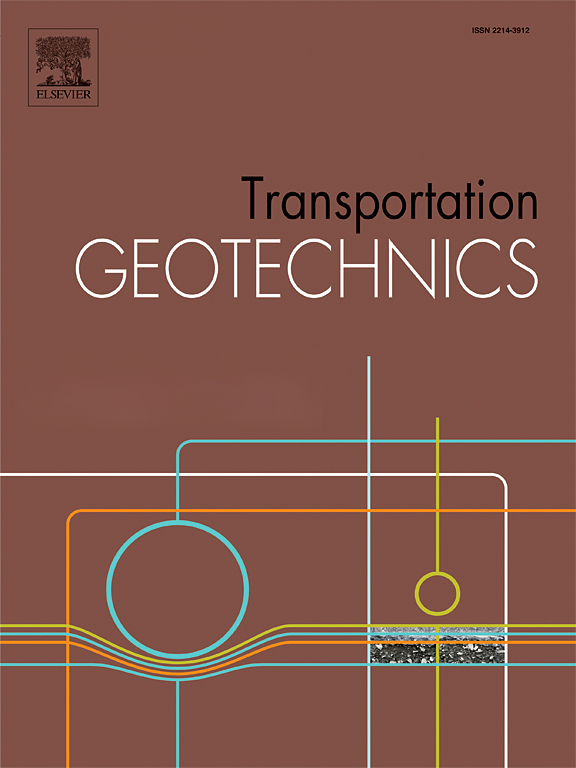Predicting strain energy causing soil liquefaction
IF 4.9
2区 工程技术
Q1 ENGINEERING, CIVIL
引用次数: 0
Abstract
Liquefaction, which typically occurs in saturated sandy soil deposits, is one of the destructive phenomena that can occur during an earthquake. When the soil reaches liquefied state, it loses a significant amount of resistance and stiffness, which often results in widespread catastrophic damages. Therefore, accurate evaluating the potential of soil liquefaction occurrence is of great importance in earthquake geotechnical designs in regions prone to this phenomenon. The strain energy-based approach is a novel robustness technique to evaluate liquefaction potential. In the current research, 165 laboratory data sets from cyclic experiments were collected and analyzed. A predictive model using gene expression programming (GEP) was proposed to assess strain energy needed for occurrence of soil liquefaction. Assessing physical behavior of developed GEP-based model was conducted through sensitivity analysis. Performance of GEP-based was validated by comparing with a series of centrifuge experiments and cyclic triaxial tests results. Subsequently, after experimental verification of numerical modeling, the strain energy required for soil liquefaction under cyclic loading at different conditions were numerically evaluated and compared with the strain energy calculated by proposed model. Finally, the developed GEP-based model was compared with established strain energy-based relationships. The results indicated high precision of proposed GEP-based model in determination of strain energy required for soil liquefaction triggering.
预测导致土壤液化的应变能
液化通常发生在饱和的砂质土壤沉积中,是地震时可能出现的破坏现象之一。当土壤达到液化状态时,会失去大量的阻力和刚度,往往会造成大范围的灾难性破坏。因此,准确评估土壤液化发生的可能性对于易发生这种现象地区的地震岩土工程设计具有重要意义。基于应变能的方法是一种评估液化潜力的新型稳健性技术。在当前的研究中,收集并分析了 165 组实验室循环实验数据。利用基因表达编程(GEP)提出了一个预测模型,用于评估发生土壤液化所需的应变能。通过敏感性分析评估了基于 GEP 开发的模型的物理行为。通过与一系列离心实验和循环三轴试验结果进行比较,验证了基于 GEP 的模型的性能。随后,在对数值模型进行实验验证后,对不同条件下循环荷载下土壤液化所需的应变能进行了数值评估,并与所建模型计算出的应变能进行了比较。最后,将所开发的基于 GEP 的模型与已建立的基于应变能的关系进行了比较。结果表明,所提出的基于 GEP 的模型在确定引发土壤液化所需的应变能方面具有很高的精度。
本文章由计算机程序翻译,如有差异,请以英文原文为准。
求助全文
约1分钟内获得全文
求助全文
来源期刊

Transportation Geotechnics
Social Sciences-Transportation
CiteScore
8.10
自引率
11.30%
发文量
194
审稿时长
51 days
期刊介绍:
Transportation Geotechnics is a journal dedicated to publishing high-quality, theoretical, and applied papers that cover all facets of geotechnics for transportation infrastructure such as roads, highways, railways, underground railways, airfields, and waterways. The journal places a special emphasis on case studies that present original work relevant to the sustainable construction of transportation infrastructure. The scope of topics it addresses includes the geotechnical properties of geomaterials for sustainable and rational design and construction, the behavior of compacted and stabilized geomaterials, the use of geosynthetics and reinforcement in constructed layers and interlayers, ground improvement and slope stability for transportation infrastructures, compaction technology and management, maintenance technology, the impact of climate, embankments for highways and high-speed trains, transition zones, dredging, underwater geotechnics for infrastructure purposes, and the modeling of multi-layered structures and supporting ground under dynamic and repeated loads.
 求助内容:
求助内容: 应助结果提醒方式:
应助结果提醒方式:


